#Sawmill Structures
Explore tagged Tumblr posts
Text
1970 and a January 1st Rock Ranch Report

View On WordPress
#1970#cardboard sheet mulching#dailyprompt#dailyprompt-2161#education#flood control#frustration#history#humour#permaculture#Sawmill Structures#soil science#Steve Balla#tranquilsolutionscanada.com
0 notes
Text
Some locations and structures to include in your forest
Abandoned shrine
Alchemist’s lab
Ancient ruins
Army encampment
Battlefield memorial
Boathouse
Bridge, log
Bridge, stone arch
Bridge, suspension
Bridge, wooden beam
Causeway
Cablin
Cable car station
Cairns- grave markers
Cairns- trail marker
Cave system
Caved-in tunnel
Cemetery
Clearing
Campsite
Castle (robber baron or otherwise)
Collapsed building
Dam
Dirt track
Ditch, defensive
Ditch, henge monument
Dock
Dragon’s lair
Elven settlement
Fairy ring
Farm
Ferry landing
Ford
Fort, earthen
Fort, stone
Fort, wooden
Game trail
Ghost town
Guardhouse
Haunted ruins
Hermit’s hut
Hollow hill
Hunting lodge
Hunter’s hide
Inn
Logging camp
Manor house
Mine
Monastery
Outlaw’s hideout
Overgrown ruins
Potholes
Paved road
Portal
Quarry
Railroad
Rail station
Raised platform
Roadside grave
Sacred grove
Sawmill
Sky burial platform
Signpost
Stone circle
Summoning ring
Switchback
Temple
Tollbooth
Treehouse
Troll cave
Tunnel entrance
Turnpike
Village
Waterwheel
Watchtower, stone
Watchtower, wooden
Witches’ cottage
Wizard’s tower
Zip line
#writing#creative writing#writing inspiration#writing ideas#writing prompts#worldbuilding#writer#writers#writing community#writer on tumblr#writeblr
3K notes
·
View notes
Text
Her life was completely upended in early November of 2018, amid one of the driest autumns on record in the Sierra Nevada, when the deadly Camp Fire swept into her hometown of Paradise, Calif., killing 85 people and destroying nearly 19,000 structures — the most expensive climate-related disaster in the world that year. "There are positives," she says. "My family got out alive." But Foudray's family home, a two-bedroom two-bath mobile, was a total loss. Five years later, she's still mostly living in an RV on her burned-out lot, hoping to get a new home within the next year.
[...] In the weeks and months immediately after the Camp Fire, survivors were anxious to get home. They soon became frustrated, angry about the slow pace of even just removing the fire debris. Then as the months dragged on, the scope of what was ahead began to settle in. It took nine months just to remove all the hazardous toxins and debris piles before the first homes could be rebuilt. Paradise's recovery had a lot stacked against it from the beginning due to its largely elderly and low-income population. Many were forced to leave in search of affordable housing.
[...] Originally built out into dense forests, Paradise today is a changed land. One million trees have been removed; the coastal range to the west and Sawmill Peak and the Sierra foothills to the east are now visible. Roads are being newly paved or reconfigured and blocked by flaggers. Utility crews are digging trenches and burying all the new power lines underground. And main thoroughfares are clogged with construction traffic. All the new homes have to meet tougher wildfire codes, including a new local ordinance that bans any porches or other fixtures built from combustible materials in the immediate perimeter of houses.
[...] This costs a lot of money. And it turns out a lot of the aid coming into disaster areas — like the millions pouring into Lahaina right now — tends to go to rebuilding infrastructure, not individual private homes. "We're not good at this in our country," says Ed Mayer, executive director of the Housing Authority for Butte County, which includes Paradise. "Our history of disasters, and no fault of their own, FEMA sort of has a one size fits all approach." The U.S. government typically comes in and tries to help people find temporary housing quickly while disaster victims figure out how to rebuild. But Mayer says that doesn't work in states like California and Hawaii where there has been a worsening affordable housing crisis for years. "Our wish at the very outset of this disaster was, hey, we want some soap bubble housing," Mayer says. "And when I say soap bubble housing, we want some housing we can erect tomorrow."
Still, five years later, Mayer's office is celebrating some successes. There are some 3,000 affordable housing units now in development in the county, thanks in large part to housing officials leveraging aid and various grants. Most are not in Paradise, however, and officials say it's probably a fraction of what's actually needed. In the days after the fire, an estimated 35,000 displaced people flooded into nearby cities like Chico.
79 notes
·
View notes
Text
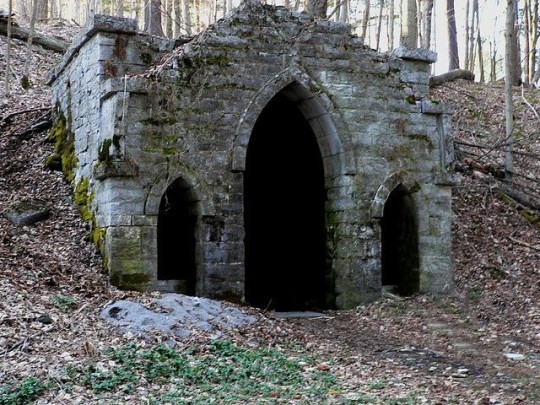
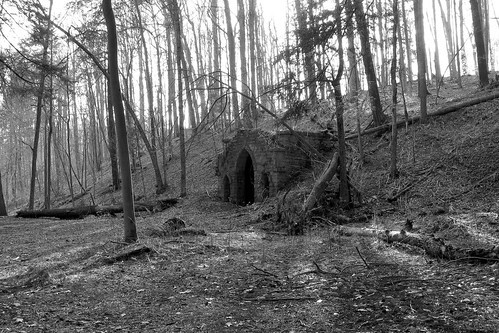
The mausoleum is hidden in the woods off a seasonal road not far from Beardslee Castle and "Beardslee Falls" in the East Canada Creek. It was built by Augustus Beardslee and stands on private land. The crypt and nearby area is rumored to be haunted. Unfortunately, many years ago the mausoleum was vandalized and some of the bodies inside were desecrated. The metal gates are gone and all that remains now is the stone structure. The contents were moved to a cemetery somewhere in the nearby City of Little Falls as far as I understand. It does not seem to be maintained in any way.
It is also one of the few remaining makers for a community that once existed in this area called "Beardslee's Mills" or "Beardslee's City."
From The Evening Telegram; Local, Saturday, September 2, 2000:
"It represents a bygone era when the Beardslee family lived on East Creek in Manheim and helped bring prosperity to the area. John Beardslee was the pioneer of the family to first settle East Creek. Born in 1759 in Sharon, Conn., he moved to the Mohawk Valley where he undertook many building projects including mills in the Utica-Whitestown area and a number of bridges in the Little Falls and Fort Plain area. He liked the area and in 1794 purchased a 100-acre tract on which he built a home and mills along the creek in the town of Manheim. A settlement grew up around his home called Beardslee's Mills or Beardslee's City. By 1800, the town consisted of two stores, two taverns, a blacksmith shop, nail factory, cooperage, a brewery, a sawmill and grist mill. When the Mohawk Turnpike and the Erie Canal came along, trade began to dwindle because of the lack of proximity to the two main thoroughfares and the village slowly declined. All that remains today is the old cemetery located near the Beardslee Mausoleum, hidden from view in the woods."
(source)
273 notes
·
View notes
Text
ONCE THE FIRE FADES: TERRITORY MAPS
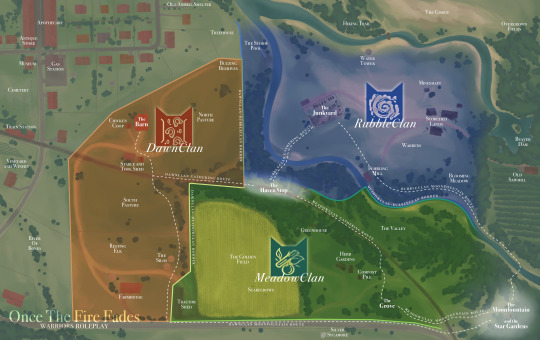

─── ⋆⋅ ♰ ⋅⋆ ───
The Territories of Once the Fire Fades are vast and expansive, containing a multitude of inhabitants from all walks of life. All equally striving towards survival, for hope shines within the glowing embers of countless tribulations. DawnClan, MeadowClan, and RubbleClan have each carved out a space for themselves inside The Ashen Plains’ heart, where 10 generations of cats have laid their paws along these fields, rivers, and valleys, though more lies past even the hard-fought reaches Clan borders define.
─── ⋆⋅ ♰ ⋅⋆ ───
DawnClan’s territory is an awe-inspiring expanse of pastures and ranging fields, open sky overhead and the roaming of larger-than-life livestock surrounding. Creatures of all kinds reside within the flatlands; both bountiful prey and ghastly predators alike lurking in these gleaming fields. A large barn makes up DawnClan’s camp, though the greater Ranch managed by twolegs provides abundant opportunities for the felines which live there. It appears the horizon goes on for countless days out here, and DawnClan cats race along every stretch of these grasslands with vigor.
MeadowClan’s territory is a gorgeous landscape of lush orchards and quiet meadows, flora blooming in vivid boughs throughout their sheltered hideaway. A pleasant smelling grove of orange trees house MeadowClan’s camp, herb gardens alongside a desolate greenhouse providing them with a rich harvest of herbs every season. A large field tended by twolegs on growling tractors makes up a good section of their territory, the opposite side home to a much more solitary valley lined by dense patches of forest. There is no lack of peaceful glens inside MeadowClan’s home.
RubbleClan’s territory is a desolate scorched delta, guarded on both sides by stormy, churning rivers. Items from the northern twoleg city get swept into the deluge, polluting the environment yet adding a unique sort of benefit for those crafty enough to make use of them. A smaller twoleg settlement used to reside within their territory, however now nothing but broken skeletons of spindly dens licked bare by flames remain. An ominous collection of long since deceased monsters overtaken by nature makes up RubbleClan’s camp, beaten dirt paths spiraling out from it and towards severe rock formations which were once prosperous mines.
Outsider territory is as ranging as it is varied, circling The Ashen Plains from all sides. A long, seemingly endless road with no destination marks the southern border, monsters and hungry scavengers traversing the rough asphalt. To the north is a rural twoleg town, its roots having been laid since before the first Clan even formed. Many dusty, vintage stores group together here, an epicenter of twoleg activity despite how aged the very ambiance seems—relics frozen in time. The northeast is known for a surging river of their own, ancient gorges, overgrown fields, and wild woodland primarily left untouched outside the occasional hiking trail and bridge. Twoleg hunters preside here, and danger lies around every corner for the loners who make the trek. A sawmill and unnatural lines of meticulously structured arbor takes up the east, a foreboding yet solemn location few ever journey past. The west is desolate pastures, rivers that have long since dried and only bones left recount since forgotten memories. Alongside basks a lone train station, still echoing with vestiges of past abandonment, forever holding vigil.
─── ⋆⋅ ♰ ⋅⋆ ───
(( ac: @//birdkiye on youtube, assets and map layouts are not free to use ))
20 notes
·
View notes
Text
The Harris Sawmill

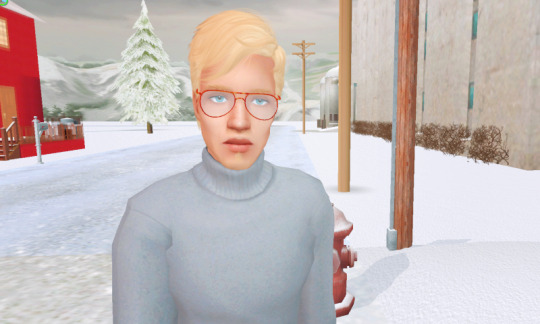
The Harris Sawmill, a prominent structure at the edge of town, stands as a testament to the community's industrious spirit. It’s one of the primary sources of employment in the small town, providing essential materials and craftsmanship that support both local needs and exports. Through many generations, the Harris family has owned this sawmill, and as of today, Michael Harris continues this tradition.

The heart of the operation is the expansive sawmill floor, filled with the hum of machinery and the rhythmic sound of saws cutting through timber. Here, logs are transformed into beams, planks, and various wood products.
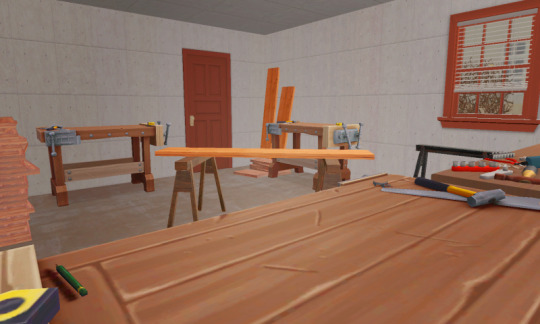
Adjacent to the main floor is a workshop where workers build and assemble various wooden structures. This area is stocked with tools and workbenches, creating a space where creativity and craftsmanship converge. From custom furniture to intricate carvings, the workshop showcases the town’s skilled artisans.
As of year 2, the employees of the sawmill are:

Markus Estrada: Foreman. As the foreman, Markus oversees the day-to-day operations on the floor. He ensures that the work is done safely and efficiently, balancing the demands of Michael with the needs of the workers. His leadership is respected, providing a buffer between the workers and Michael’s stringent expectations.
Bill Kwon: Welder. Bill handles all the metalwork, ensuring that the machinery is well-maintained and that any custom metal fittings or repairs are expertly executed. His precision and skill are vital to the smooth running of the sawmill.
Nasir Bahij. Crane Operator. Nasir skillfully operates the crane, moving large logs and heavy materials with ease. His role is critical in maintaining the flow of raw materials into the sawmill and finished products out to customers.
Max Ford. Cladding Installer. Max specializes in cladding, applying finishes and protective layers to wood products. Her attention to detail ensures that the sawmill’s output meets the highest standards of durability and aesthetics.
Damian Murphy. Drill Press Operator. Damian operates the drill press, creating precise holes and cuts needed for various wood products. His meticulous nature and technical expertise contribute significantly to the quality of the mill’s craftsmanship.

At the front of the sawmill is a small hardware store managed by Michael Harris. The store is well-stocked with tools, building materials, and supplies needed for both professional projects and DIY endeavors.
51 notes
·
View notes
Text
Classes in the Wizarding World. Why don't wizards have an "upper class" linked to wealth? And where do the wealth of the Malfoys and the Blacks come from, and how could wizards become rich?
Alright, this will be controversial, as there seems to be a widely accepted HC that wizards have exactly the same class divisions as Muggles, and I see a lot of metas where poor wizards are referred to as the "working class." I respect all opinions, but I want to express mine :) I disagree with this because the Wizarding world does not imply a replication of the Muggle social structure. The main argument about why there are no classes tied to wealth is that purebloods don’t have any exclusive access to means of production. The wizarding world isn’t like the muggle world, and their class structures are different. Magic fundamentally changes the entire structure of society.
In the muggle world, classes were primarily divided based on their access to wealth, economic resources, and means of production. If one part of society monopolises all the land, then you have classes of landlords and peasants. If one part of society owns factories and plants, holds stocks and capital, while another works at these factories, you have classes of capitalists and proletarians. Wizards don't have such classes. Strictly speaking, if we divide wizards into wealth-based "upper" and "lower" classes, we need to show where exactly the upper class has or ever had exclusive access to means of production that gave them the "privilege" to be called the "upper class". This is impossible to show because it doesn’t exist in the Wizarding world.
However, they do have a clear different way of dividing society.
But let's take it step by step.
In its time, the muggle upper class of the feudal society was too tied to "land" and the idea of land, which evolved into snobbery towards commerce and business because commerce allowed wealth beyond the nobility. This upper class felt their exceptional privilege. Their position was given to them at birth. But the emerging middle class... They were simply "mercantile" merchants. Many held beliefs in the superiority of feudal values and considered trade and business less honourable pursuits. Some nobles could also manage various enterprises related to agriculture, including mills, wineries, and sawmills. (Pure-blood wizards look much the same, but they don't have titles or lands, they have their blood. Your wealth doesn't matter if you're a pure-blood wizard. Take a look at the Black family tree. It's clear that not all of them were wealthy. I'm sure that many of these wizards had quite modest means. The Malfoys were an exception, but more on that later.)
When the English Revolution occurred, followed by the Industrial Revolution, and capitalists began to get very rich, while nobles unexpectedly started getting poorer, there was even stronger prejudice against "flaunting money," as it became associated with the newly wealthy lower class. Because true upper-class status isn't just about gold, and a capitalist will never have what they do – their family names and status given by God himself. Yes, among the nobles, there could also be entrepreneurs engaged in trade or investing in various projects, mining development, but the trend still leaned towards the impoverishment of aristocrats.
The Industrial Revolution happened after the imposition of the Statute, but the English Revolution came before. Obviously, wizards didn't have an industrial revolution. It's unclear how their production worked at all. Much of their production relied simply on craft workers. There are businesses like potion-making, Sleekeazy's Hair Potion production, broomstick manufacturing, although these "businesses" might look more like artisanal enterprises. Additionally, there's definitely a black market, but it's quite small. And let's not forget, in the world of Harry Potter, there's "slave labor."
Moreover, their main means of production is magic. And everyone has magic. Their production primarily requires knowledge and skills and doesn't require any significant physical infrastructure. Meanwhile, Hogwarts is free and accessible to all by birthright. Yes, access to raw materials may be limited, and these materials may indeed be owned by wealthy families, but for the most part, we don't see resources that are impossible to obtain independently. Another point is that students don't invent anything themselves over the seven years... Where's the theory of magic?! How to create spells?! Perhaps this needs to be self-taught.
Well, it's entirely obvious that they don't have peasants either, so there's no exclusive access to wealth for pure-bloods based on the feudal system either.
So, no classes based on wealth can exist for them simply because pure-bloods don't have any exclusive access to resources or means of production. A wizard born pureblood doesn't get anything at all for their blood, except connections.
Essentially, connections and blood itself are their exclusive resources, which they try to increase. Pure-bloods find it easier to get the right jobs, to get a job at the Ministry, and so on. Also Muggle-borns who became a part of the WW, presumably, could encounter difficulties getting hired or be paid less. But they could always start their own craft production of something. They had the main means of production – magic. But they lacked connections and social capital. Over time in the Wizarding World, Muggle-borns or half-bloods, judging from canon, could also get a job at the Ministry and even become Minister of Magic. Moreover, they created their own small craft-based enterprises or worked for other craftsmen and traders.
The Malfoys are likely those from former "Muggle aristocrats" who always kept a finger on the pulse and were well-connected in the Muggle world. They quickly figured out how to make even more money rather than just relying on income from land, although they also expanded their lands (they have managed to add to their lands in Wiltshire by annexing those of neighbouring Muggles). We know they keep a Rolls-Royce in their garage and have a collection of Muggle art (the favour they curried with royalty added Muggle treasures and works of art to an ever-expanding collection). It's not surprising if they invested in some muggle businesses. Essentially, the Malfoys are blood traitors, considering they had half-bloods in the family, but the family is too cunning and clever, so they maintain their position over the centuries. The Malfoys have always had a reputation as a slippery family, striving for power and wealth wherever they are.
The result is that they are one of the richest wizarding families in Britain, and it has been rumoured for many years (though never proven) that over the centuries the family has dabbled successfully in Muggle currency and assets.
Some other families were probably also Muggle aristocrats before the imposition of the Statute and owned some lands, but even if they still had these lands after the Statute was imposed, what good are these lands without peasants? Land doesn't monetise itself. The Statute assumes complete disappearance from the Muggle world, meaning these lands became invisible to Muggles and were either used for wizards and their internal agriculture or simply remained dead weight, as there is no demand for land in the WW as a resource. Considering magical means of production, cultivating land was very simple and efficient, so there were never any problems with food in the Wizarding world. And they didn't even need much land to provide all wizards with the agricultural products they needed. Additionally, house-elves could work on it. Furthermore, over time, many wizards owned their own gardens in different parts of the country and could grow food for themselves (for example, the Weasleys actually have their own farm, and Hogwarts definitely has pumpkins and poultry).
Moreover, strictly according to canon, food can be duplicated... Perhaps it's incredibly complex magic, so ordinary wizards can’t do it, but there are special wizard craftsmen who trade in duplicated food. Perhaps this food isn't as tasty.
Also, I headcanon that not all families agreed to hide precisely because they didn't want to lose their statuses and potential wealth.
The Malfoys also resisted to the imposition of the Statute, although they later denied it.
Historically, the Malfoys drew a sharp distinction between poor Muggles and those with wealth and authority. Until the imposition of the Statute of Secrecy in 1692, the Malfoy family was active within high-born Muggle circles, and it is said that their fervent opposition to the imposition of the Statute was due, in part, to the fact that they would have to withdraw from this enjoyable sphere of social life.
Likely, families like the Blacks and the Lestranges originally supported the imposition of the Statute.
Overall, the Malfoys' wealth was colossal; obviously, they were and remain the wealthiest in the WW. Perhaps the wealth of the Blacks and the Lestranges also persisted from the time when they were Muggle aristocrats. The Malfoys invested in the Muggle sector of the economy. The Blacks and the Lestranges might have invested their money in building Diagon Alley or income properties in Hogsmeade, or they could have been involved in the gray and black markets of the Wizarding World. They could also own magical mines, but it's unknown if this was allowed in the Wizarding world. Other families might have started some small businesses–broomsticks, wand production, potions, cauldrons, and so on. The Potters invented a potion and sold it and became "very rich." Well, suppose they exported their potion to other countries because they couldn't become "very rich" on the domestic market alone. The market is tiny. Or their "very great wealth" is greatly exaggerated.
We know that some pure-blood families pass down their trades from generation to generation, but that doesn't make them really wealthy. Still, they're considered noble. And the Gaunts are "noble" but very poor. Nobility can't be earned, but it can be lost quickly – like becoming a blood traitor. Take the Weasleys, for instance, who were considered noble even in the 1900s.
Families like the Umbridge have no connection to "nobility," but they really want it. They're desperate to belong: "I am related to the Selwyns... Indeed, there are few pure-blood families to whom I am not related. A pity... that the same cannot be said for you. 'Parents profession: greengrocers.'"
In a mockingly imitation of a Black: 'Typical half-blood. She doesn’t even understand our society!'
When a true Slytherin heir appears, even the Malfoys are willing to tone down their arrogance. The first Death Eaters followed Tom for this reason–he's the heir of Slytherin. It's a very high status among their society.
But the Malfoys' arrogance about money is probably because they had many connections with the Muggle world, the Muggle economy, and their personal views on money. They also continued to adopt the ways of Muggle capitalist society.
Sure, wizards wanted to get rich, but the wealth of individual families like the Lestranges, Blacks, and Malfoys wasn't class-based for the wizarding society. Firstly, a class of three families can't exist, and they don't have anything specifically exclusive that would set these three families apart in their access to wealth. What they possibly retained from pre-Statute life can't be the basis for forming a new class in the wizarding society. It just doesn't work like that.
Moreover, it seems that significant wealth could only be attained through innovations, as they also didn't have an internal investment market, financial instruments were absent, and Gringotts simply stored their gold. Okay, gold itself increased in value, but they constantly withdrew money for their living expenses, so capital must have been leaking out too. I suppose many families that were wealthy before the Statute quickly spent their large fortunes if they didn't adapt to the new conditions.
44 notes
·
View notes
Text
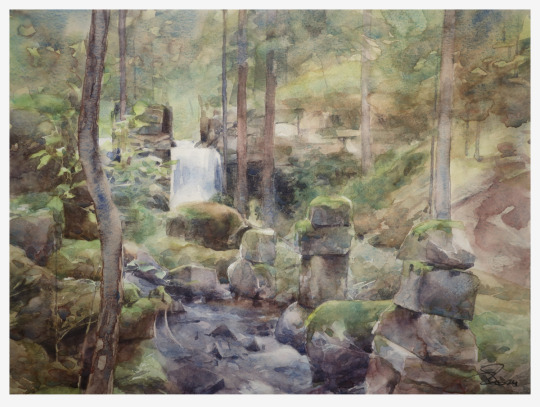
Den gamla sågen, akvarell, 36x26,5 cm
Förra sommaren tog pappa med mig på en rundtur till vackra platser i den delen av Värmland där jag växte upp. Det sista stoppet var de här lämningarna av en gammal såg. Det var som att se en uråldrig ruin i skogen, där träd, mossor och lavar hade börjat återta strukturer byggda av människan, men den här sågen var i bruk ända till 1940-talet och sysselsatte sex (eller var det nio?) personer. Nu finns det en avverkningsanmälan på skogen runtom den här platsen, så jag vet inte vad som kommer att vara kvar av det här nästa gång jag som jag åker dit. Känns så sorgligt.
...
The old sawmill, watercolour, 36x26,5 cm Last summer, my dad took me on a tour of beautiful places around the parts of Värmland where I grew up. The last stop was these remnants of an old sawmill. It it was like seeing an ancient ruin in the forest, where trees, mosses and lichens had started to repossess the man made structures, but this sawmill was in use until the 1940's and employed six (or was it 9?) people. Now there's a notification for logging the forest around this place, so I don't know what will be left of this the next time I go there. Makes my heart sink.
#laxholmen kulturhus#human nature 2024#skog#natur#akvarell#konst#måleri#forest#nature#watercolour#watercolor#watercolor painting#watercolor art#landscape art#aquarelle#acuarela#aquarela#acquerello#ακουαρέλα#suluboya#akwarela#акварель#水彩#peace#petter brorson edh
53 notes
·
View notes
Text
Sawmill Park

(Night In The Woods)
From all the "Rooms" in the entire game this hits the hardest for me.
There's a park that's similar to this near my home, so that's maybe why it's so nostalgic. There's also an absurdly hazardous structure, so it's even more similar.
(Sorry if I got the incisions wrong, in every reference I used were really blurry)

+(really) really dumb joke:

#There was this Torre Eiffel-like structure but with ropes.#It was really tall and I remember being a go-to attraction for us kids.#Recently (as in 2 or 3 years ago) they dismantled it.#Kinda sad how new kids won't experience it (the park is barren without it).#Though it was a HUGE safety hazard.#Tall enough for unsupervised children to break their necks.#It also had a giant metal pole in the middle that attracted lots of lighting so that's another reason why it had to go.#sorry if the image-id description is off (it's the first time I'm trying to describe my drawings.)#barra art#art#night in the woods#nitw#barra-practice#background#described#pixel art#nitw fanart
16 notes
·
View notes
Text
Saturday Movie Night: Railscale 1
Here's an idea I've been sitting on for ages, which I hope will become a semi-regular feature on this here blog. It's a pretty basic idea - every week (if I remember), I share a video on here which I think you guys would be interested in seeing. Naturally, that means a lot of the videos will be to do with Thomas, or real-life railways (real and model), or anything else I decide is worth sharing.
I don't know if anyone here has heard of Phil Parker, but yes, I am basically ripping off the Saturday Film Club feature he does on his blog.
youtube
You may well remember me talking about Railscale a couple of years back. Well, since then, someone's gone and uploaded all three issues to YouTube (see that earlier post for why there were no more). So I thought, what better way to kick off this semi-regular feature?
See above to watch the programme, and see below for more details about the contents.
THE BROMFORD & HIGH PEAK RAILWAY (7mm/O)
This huge, spectacular O gauge layout was deliberately shrouded in mystery by its creator, Ferrari importer Ronnie Hoare. For security and insurance reasons, he rarely allowed visitors to the layout - the Railscale team were thus privileged to be allowed to film it for this feature. The layout itself featured over a scale mile of track, and included models from some of the country's leading model makers.
INSIDE A SAWMILL (7mm/O)
We next look around Les Tindal's scale model of an American sawmill of the interwar period. The sequence shows how Les adds details and develops scenery, and finishes with a look at huge he achieves the authentic weathering of timbers and metals.
PECORAMA (Various)
Pecorama is a permanent model railway exhibition in sunny south Devon, own and operated by the PECO company. They believe that any house or flat can accommodate a model railway, and the layouts on display have been made with this philosophy in mind.
WINCHESTER CHESIL (4mm/P4)
The Scalefour Society was one of the leading pioneers in the great push towards greater realism for model railways. This exact scale model of the GWR's Winchester station was made by society members from the Southampton area, and they take up the story of how the model came into being.
BOYTON CROSSING - PART 1 (4mm/OO)
The first in a series of segments demonstrating the construction of a model building - based on the crossing keeper's cottage at Boyton, on the Salisbury-Warminster line. Railscale's resident model maker, Mike Jolly, talks us through the process of researching and measuring the prototype, before building up the basic structure with card and embossed sheets.
LIVE STEAM ON THE ISLE OF MULL (Live Steam/10.25")
In 1984, a miniature railway opened on the Scottish island of Mull, linking Torosay Castle to the ferry pier at Craignure. The line has since developed into a tourist attraction in its own right. Nick Dodson of Railfilms shows us around, and talks with founder Graham Ellis.
PROJECT N - PART 1 (2mm/N)
Mike Jolly returns to commence the construction of an N gauge layout. After deciding on the plan, he chooses and cuts the timber, and makes a start on assembling the baseboard.
COACH CONVERSION (2mm/N)
Railscale 1 concludes with this short segment, demonstrating how to convert a Graham Farish BR Mk2 coach, to represent types not available in the ready-to-run market.
12 notes
·
View notes
Note
What about you? What writing are you happy about this year?? Is there anything you want to brag about?
Happy Yule, solstice, Christmas, Festivus, (belated) Hanukkah, Kwanzaa, and Doctor Who Day! And anything else you might celebrate, or happy Monday if you don’t!
Thank you so so much for asking 🧡🧡
This was quite a writing year for me. I wrote only four stories, but I'm quite proud of all of them. To Love Somebody was my first foray in rare pairs. An angsty backstory for Shadwell, and what made him the way he is. It has an hopeful ending, and I'm quite proud of the structure, and how much I managed to squeeze into the small word count. Girls Just Wanna Have Fun is a short and wholesome outsider pov story I wrote for an event. I was surprised how much people liked it! It was also my first attempt on present tense, which continued in A Stable Relationship, one of my FTH stories for this year (the second one will probably be a bit late, and be completed in January). I had fun writing it, and it turned out to be a good one, and the only one of these oneshots that was Explicit. It was set in horse riding world.
The reason why I wrote only three oneshots, and why my second FTH piece is late, was of course my favourite story of all time: Be Still My Soul trilogy. A human AU story set in the sad moments of Finnish history.
Despite the class differences, landowner Azirafel Fjäll and sawmill worker Anton Crowley have been friends since childhood. The Great War rages over Europe and the Empire of Russia is in the firm grip of a revolution. The echoes of these fateful events carry over to the Grand Duchy of Finland, vaguely sauntering towards independence. Azirafel and Crowley find themselves on the opposite sides of a conflict that will eventually lead to a bitter civil war, tearing the country apart.
Is there a possibility for them to find their own side, or will this be the end of their budding love story?
I started writing the third part in January, and finished it just before S2 aired in July. It finished posting in October, and it's now complete and done, though I'm still commissioning art for it. This story took over my life for over two years, and it's my baby. I've had such a hard time to let go of it! It also has its own blog @be-still-my-soul-fanfic where I posted dozens of posts about historical and cultural facts. The story is written in a way you don't need to know anything of the Finnish history beforehand (my American betas made sure of that). It's a lovestory, not a history lesson, BUT if you want to learn more, there's a lot of extra info available 😅
I think it's the best story I've ever written (and probably ever will). Many readers have agreed, but it's angsty with very heavy themes until the happy ending, so it's not for everyone and I think posting it just when S2 aired cut some of the potential readers. The third part of the trilogy is now five kudos shy of 100 kudos, and I'm hoping it could get past that milestone before new years. 😂 So yeah, my own personal favourite gets the least interaction of them all. Oh well.
I'm gonna sound a bit self-absorbed, but I'm proud I finished it and it turned out even better than I hoped. My dream would be to print a physical copy or to record a podfic of that, but both might be a bit too much work.
For the next year I have two zine fics to finish, and I have applied to a third one. I have one event fic in the works as well, but the FTH story will be the one I'll concentrate until it's done. It's an oneshot human AU which somehow grew limbs and now it's 7.6k words and nowhere near done 😱 That's my holiday project.
Thank you for asking!! I was so delighted to get a chance to ramble myself 🧡 There's never enough chances for writers to gush about their own work because it always feels a bit self centered. That's why I like to wander around Tumblr and give people the perfect excuse to do that! Peek at the #writer's favourites tag if you want to see other fanfic writers sharing their favourites! And feel free to use the tag yourself if I forgot to ask someone (I was very much not organised when going through the blogs and I'm not good at matching blog names with writer names 😅)
I hope you'll have a magnificent new year 🧡
15 notes
·
View notes
Text
Saturday, November 9 Rock Farm Report
Action in the bush! HUNTERS, take note.
#education#Evolve Builders Group#Evolve_Builders#frustration#hunting season#integrated pest management#Kubota#natural building materials#Owen Sound Farmer&039;s Market#Sawmill Structures#sewage#tranquilsolutionscanada.com#waste water systems#wood pellet boiler system#www.designelectrical.ca
0 notes
Text

2024-10-09: Area 09 (Pacific Timber Sawmill)
One of the earliest structures in town is the sawmill, which predated the founding of the town. It has mostly remained in the same location since it was constructed in 1848, though it has burned down twice (once in 1855 and again in 1863). The rebuilt sawmill was constructed next to the ruins of the old mill, adjusting slightly for changes in the path of the Klamath River.
While lumber harvested in the Willamette Valley to the northwest is exported to the Sandwich Islands (Hawai'i), most of the lumber from Bowman is exported to Nevada and Arizona. Trees are cut by two person teams with large hand-operated crosscut saws, and the felled logs are loaded into carts (or dumping them into waterways that lead to the Klamath River) to be processed into lumber. The sawmill has two carriage ramps, one on the river and the other on land, to bring the logs into the mill proper.
The current incarnation of the Pacific Timber sawmill uses a circular saw that's powered by a steam engine, though the previous versions used up-down/sash saws. The mill is owned by Bill Whitney, a profit-focused city slicker who only visits Bowman once or twice a year to inspect the mill and raise hell about how the workers aren't working hard enough. However, the real face of the daily operations is Vic Phelps, a bearded rectangle of a man whose frame has gotten ever-so-slightly more plump from the relative comfort of his position as the mill's manager. Rumor has it that Bill might be coming to town soon, though, and Vic needs all the help he can get to make the mill presentable enough for Bill's visit.
Additional Research Materials
I don't have personal experience with sawmills, so I must turn to the internet for assistance. Here are a few things that I found useful in composing this entry:
History of Sawmills (YouTube)
Oregon History Project's "Sawmills and Agricultural Structures"
Farm And Dairy "Evolution of the Sawmill Industry"
Ledyard Sawmill's "Circular Sawmill"
2 notes
·
View notes
Text
Devlog #2 | Job prototypes
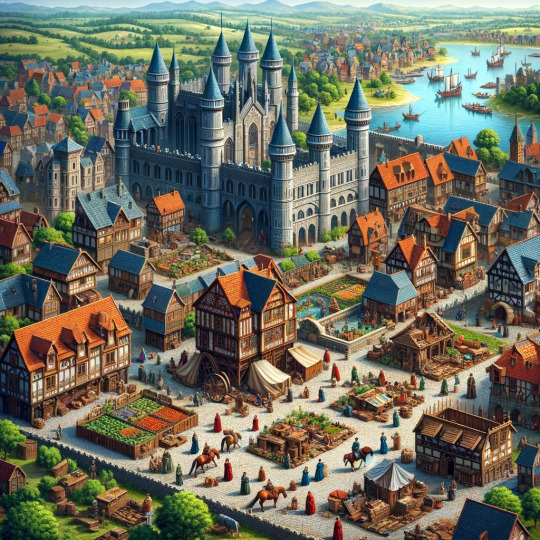
Hey folks!
In this post of my game development series, we’re going to take a closer look at some of the core functions I’ve been prototyping, specifically focusing on jobs and the management of workers within the game. I’ll walk you through the mechanisms for assigning and removing workers from tasks, and share some insights into a few of the job types that are already up and running. Enough words, let’s dive!
Workers
So, what exactly are workers? In essence, every peasant that appears on the scene is a potential worker. As soon as a peasant is 'born' into the game, they're automatically added to a specialized dictionary designed to track each peasant's status. There are actually several dictionaries managing different aspects, but the primary one records key details about each peasant, including whether they are currently assigned to a job.
In the future, all peasants will have roles, with unassigned ones handling tasks like building or transporting goods. To put it simply, at this point, there are essentially two categories of peasants: those who are assigned to specific tasks and those who are not. And those who are assigned they won’t be able to handle tasks like building.
Currently, assigning and removing workers is managed through an interface panel, separate from the direct building controls. I might integrate these systems later, but for now, this panel displays all the available job slots for your peasants, including the job title, total positions available, and how many workers are currently assigned to each role.

The process of assigning workers is straightforward: simply click the plus button and the system will automatically select a random peasant from the pool of unassigned peasants and assign them to a designated workplace. For instance, if you press the plus button for a Woodcutter role, a random free peasant will be allocated to the woodcutter's hut that has been waiting the longest for a worker. This selection is managed through an array that ranks buildings of the same job type by their waiting time for a worker. Once a worker is assigned to a workplace, they head over and begin their duties.
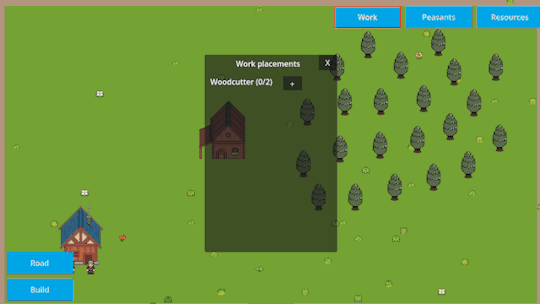
When the worker is assigned it aumatically goes to his new work placement
Removing a worker from a task is a straightforward process as well. The system simply selects the highest priority building—typically the one that a worker was most recently assigned to—and removes a worker from it. The now-unassigned worker will head back home for a bit of downtime to relax.

Unassigned worker always returns home
Current jobs
I've already implemented several prototype jobs in the game, including some basic ones that are essential for this genre. Take the woodcutter's hut, for example. This facility enables you to harvest trees and convert them into logs. Simply assign a peasant, select the area for tree cutting, and after a while, you'll have a stockpile of logs. I also added some lively animations—like a peasant pulling a cart filled with logs—which made the development process quite enjoyable.

Woodcutter cuts the tree if any are chosen. You can call selector from the building interface
The overarching concept behind all these job prototypes is integration—every building is a cog in a larger machine. I wanted to keep manufacturing processes from becoming overly complex, yet still intriguing enough to engage players in resource management. For instance, with the woodcutter's role, simply cutting logs isn't the end of the line. Those logs aren’t immediately useful for construction or as firewood for heating. They need to be processed further at a sawmill, where another worker will transform them into planks and firewood, which are essential for building structures or keeping homes warm. The idea is to gradually introduce more intricate and extended production chains as you advance in the game, adding depth and complexity to the gameplay.
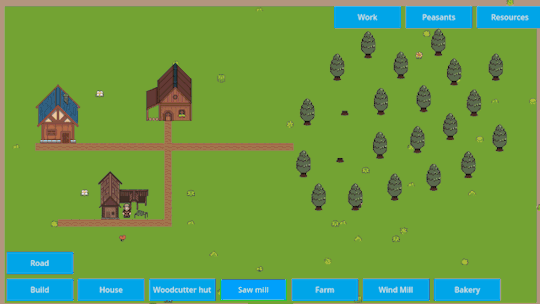
If lumberjack has some logs at his workplace - he will proceed it into a firewood and planks
There are already several prototypes in the game, and I'm currently finalizing the bread-making process. The game includes a farm where players can create dynamic fields and select the type of resource they want to grow. Once the resource, such as wheat, is harvested, it is transported to a sawmill. At the sawmill, the harvested wheat is processed into flour. The flour is then transported to a bakery, where a baker uses it to make bread.
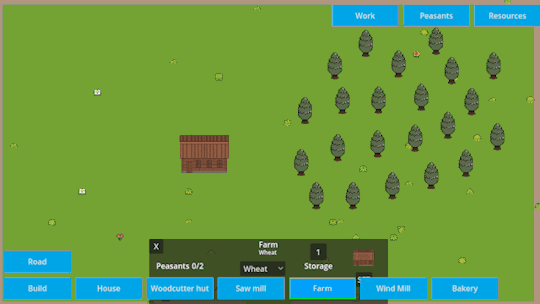
You can make your farm as big as you wish - think about your workers who will take care about it!
I hope this gives you a clear understanding of the current state of the work-related functions. They are still in the early stages, and many improvements are on the way, but overall, I am pleased with the core concept. I am particularly excited about the idea of requiring players to construct separate buildings and make strategic decisions to produce useful products.
In future posts, I will provide more information about the new and updated building system. A grid system is coming, which will be a significant change from what I currently have. Stay tuned, and feel free to ask any questions!
6 notes
·
View notes
Text
World building and theories of Engage
The architecture of Firene
I am going to start by discussing the windmills. They were a distinctive Dutch influence, possibly inspired by the Mill De Hoop, depicted in the painting 'Rotterdan, Le Moulin, Le Canal, Le Matin ' by French painter Paul Signac, 1906. They are tower mills which are vertical windmills with a stone tower with a wooden cap which can rotate so the sails face the wind. Of course windmills are used for grinding corn to make flour, however they have other applications as well; grinding herbs, creating paper from wood pulp and powering sawmills.
The shuttered houses are made of granite stone and covered by thatched roofs. Most of the peasant houses seen are thatched which could represent a long tradition of thatching and crafting. There are bread ovens and wells made of the same stone material. The peasant architecture could be inspired by the charming hamlets of Kerascoët and Kercanic. There are a few granite standing stone constructions. The importance of these man made structures is that they memorialise a notable event or are used for religious purposes.
The Castle of Firene is inspired by the Mont Saint Michel in France. It is an example of Romanesque Gothic art. The castle consists of 3 levels supported by 16 buttresses. It is an example of bold beauty combined with function. Each floor is designed and organised to perform a function. On the ground floor there is a cellar for storing food and a wine cellar as well as a public chaplaincy for welcoming pilgrims. I would imagine that as well as going to Lythos, many Firenze would also make a pilgrimage to the castle, which is also en route to the port. The second floor has a ballroom/dining room for special guests such as the Divine Dragon. The third level has the cloisters. The layers of the Mont Saint Michel are a representation of the hierarchy of feudal society. At the top there is God, or the Divine Dragon. The royalty of Firene would meditate, study and worship in the cloisters, the nearest point to Lythos and the Somniel, just below God. Below are where the royalty conduct daily business and entertain foreign royalty and the nobility. At the bottom are the stores and servant and military housing. Outside the walls are the commonfolk, farmers and other agricultural and manual workers. I believe that the commonfolk symbolically living outside the castle represents the lack of social mobility.
The castle boasts some impressive defences, very important features for a nation that desires peace. They act as a deterrent to any would-be conquerors. The fortifications include impressive walls with semi circular towers and 1 bastioned tower. In the hundred years war the English failed to capture Mont Saint Michel, despite several attempts, due to the fortifications.
The interior is inspired by the Gothic style with a hint of the Romanesque style of the Mont Saint Michel. After completing Chapter 5 - Retaking the Castle, you can explore part of the interior of Firene castle. The altar and the aisles create a spacious area full of light with some elegant stonework. A classic Romanesque feature is the symmetry of the layout. The long, tall window niches are triangular in shape and the lancet which descends towards the window is designed to create the illusion that the windows are bigger than they actually are.
3 notes
·
View notes
Text
Monday 10th July 2023
Kamloops wouldn't be our first choice for a holiday, but as a stopover location it is practical. Kamloops is a mining town; copper and gold, with the largest open cast mine operation in Canada just 30km out of town, and underground mining in town. Logging and sawmills seem popular here too. Kamloops is expanding apparently with people from Vancouver; now 115,000 population with many first nation folk living here. We were collected from our hotels yawningly early at 7.10am; required to leave suitcases in the room to be transferred by road to our hotels in Vancouver. Hopefully. A 22 coach train does not fit well into a standard station platform so we were delivered to the extended train parked in the Rocky Mountaineer depot at one side of the marshalling yards. Yards that are filling up with freight containers, stacking due to the freight operator strike. This eased our passage to Vancouver since we didn't need to pull into sidings so often to allow freight to pass. The journey began by crossing the Thompson River, through downtown with the smokestack of the pulp mill pluming upwards on the edge of town, moved by popular demand away from housing due to the smell.
The landscape was gradually changing to semi-arid desert like conditions, sun bleached hillsides and pastures: home to bald eagles, ospreys and long horn sheep. The temperature today was predicted to hit 35° which would be ideal for its growing wine industry. The baron landscape has been the setting for XFiles, The A Team, Battlestar Galactica and no doubt many more films and TV shows. As the train snaked its way along the course of the Thompson River we spotted bald eagle and osprey nests, some of the latter being up to 100 years old mainly built on manmade structures. Parent ospreys must from time to time have the conversation; one day son, all this will be yours! This is a big country, the home of ballads such as crooned by the likes of John Denver, Cowboy and Indian films, Luis Armstrong wafting over the sound system singing Wonderful World seemed to sum up the general feeling.
Thompson River soon merged with Fraser River just before lunch. The Fraser soon to be busy with salmon. The topography changing now reverting to pine forest and mountains as we headed south towards Hope and Vancouver.
It is a thing most strange that we have travelled hundreds of miles into the Rockies without meeting any English people until boarding the Rocky Mountaineer. Now all on our carriage are English or occasionally Scottish, all Radio 4 of an age. Is it only the Anglo Saxons that appreciate the permanent way? We are all practically on Christmas card terms by now, but of course all that will be forgotten by December.
The train seemed to pick up speed by the time we reached Hope where we were a fortnight ago. We were travelling a good 50mph towards Vancouver. I think the driver needed to be home by tea time. Then he really put his foot down.
And so it was we finally made it into Vancouver crossing the swing bridge. It was a very agreeable way of returning to the great metropolis of the city.
Remarkably, we were able to step off the train and onto a waiting coach which was able to take us directly to our hotel for the following two nights. What was even more remarkable, our suitcases actually made it to the coach!
We have a couple of days to enjoy ourselves in Vancouver before travelling home on Wednesday. Well didn't that go quickly.

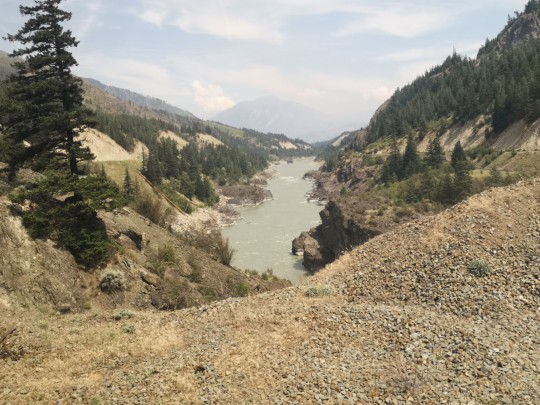
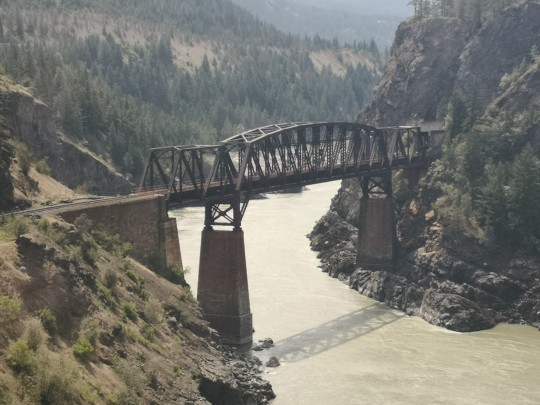




2 notes
·
View notes